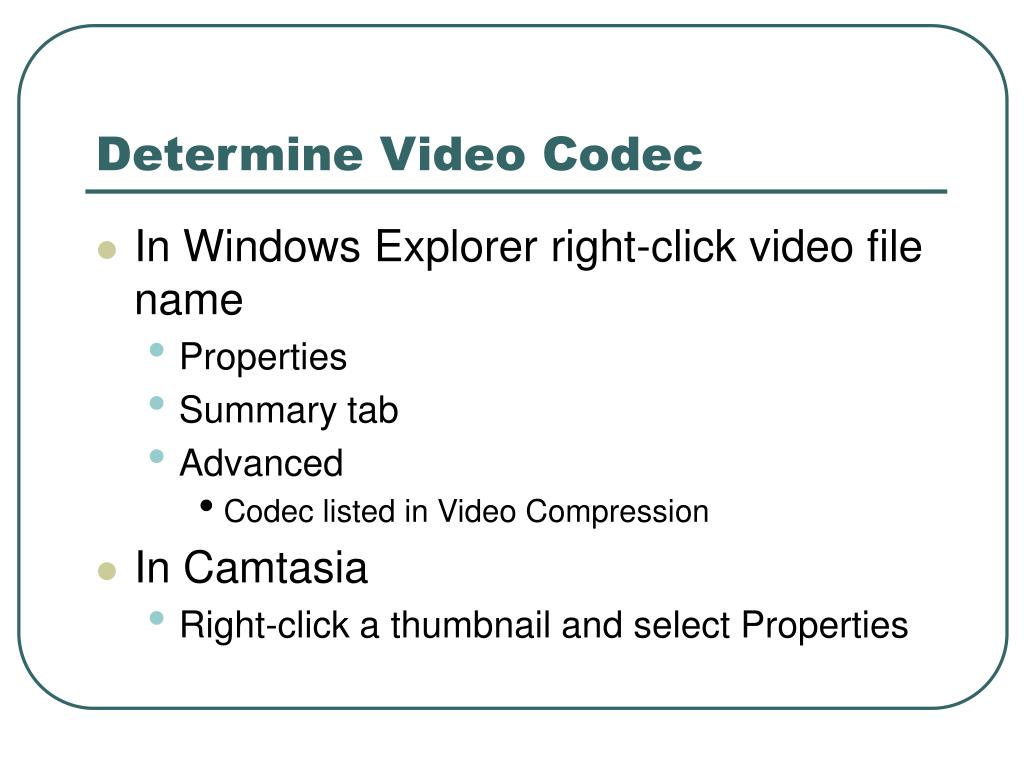

During playback, lossless codecs completely reconstruct the compressed data while lossy codecs serve up only an approximation. But out of all of them, H.264 and H.265 get the most attention by far.Ĭodecs come in two classes: lossless and lossy. MPEG-2, JPEG2000, and VP9 are just a few you might hear about.

There are lots of different video codecs out there. The codec comes into play at the start, determining how the raw footage and sound are compressed within the container, and decodes the file for playback as needed. The difference is this: A container holds the compressed video and audio and any other components of the file, such as any metadata or subtitles. For video files, that means formats like AVI, MOV, or MP4. The term itself is a combination of the words “coding” and “decoding.”Ĭodecs are often confused with containers. There are also audio codecs that do the same for audio. But what even is a “codec”?Ī video codec is a process for compressing and decompressing video data. It’s a term you’ll hear often in the streaming world and probably use a fair bit yourself. H.265: Average bandwidth required per resolution But the shift from macroblocks to CTUs is the most significant contributor to H.265’s greater efficiency. There are other technological enhancements at work, such as superior motion compensation and spatial prediction. H.265 uses a newer block structure called coding tree units (CTUs), which can process sizes of up to 64×64 pixels. H.264 uses what are called macroblocks, processing units that span 4×4 to 16×16 pixels. What accounts for this difference is how each video compression standard processes frames. This is a big advantage especially when it comes to storing and streaming 4K video and other high-resolution video content. The benefits of this are twofold: H.265 video files don’t take up as much storage space, and they require less bandwidth to stream.

The actual methodology used to encode and decode video with AVC involves three distinct phases labeled “predict”, “transform” and “encode.” The mechanics of AVC break video down into a kind of machine language that can be easily stored and accessed by a range of technologies.The H.265 codec compresses information more efficiently than H.264, resulting in files of comparable video quality that are about half the size. However, experts also point out that the storage efficiency of AVC is greater than those of some previous MPEG formats. When comparing AVC to MP4, it’s important to consider that AVC has a bigger compression ratio and longer encoding than MP4, and that more central processing power is needed.
ADVANCED VIDEO CODEC MEANING MP4
mpg.Įxperts point out that AVC is a prominent alternative to an MP4 format. In terms of its origin, AVC was developed jointly by the International Telecommunications Union (ITU-T) and the Moving Picture Experts Group (MPEG), which is a project of the ISO/IEC and familiar to many users because of popular and accessible MPEG file formats, like.

Techopedia Explains Advanced Video Coding AVC is also known as H.264 or MPEG-4 Part 10.


 0 kommentar(er)
0 kommentar(er)
